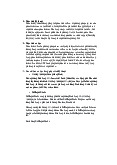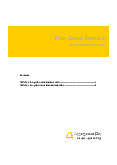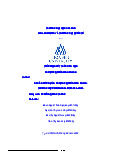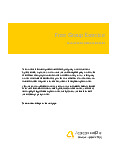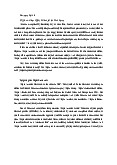




Preview text:
EXPLORING THE IMPACT OF TRADITIONAL AND
ELECTRONIC WORD OF MOUTH ON TRAVEL INTENTION Linh Nguyen Tran Cam Tung Tran Anh Massoud Moslehpour
Ho Chi Minh City Open University, Viet Saigon Institute of Technology, Vietnam Asia University Nam
Lot 14, Road 5, Quang Trung Software
No. 500 號, Liufeng Road, Wufeng
97 Vo Van Tan Street, District 3, Ho Chi City, Dist.12, HCMC, Vietnam District, Taichung City, Minh City, Vietnam tungta@saigontech.edu.vn Taiwan clinhou@gmail.com writetodrm@gmail.com Xuan Do Thi Thanh
International University – Viet Nam National University HCM City, Vietnam
Quarter 6, Linh Trung Ward, Thu Duc District, HCMC Xuandtt16@hcmiu.edu.vn ABSTRACT 2. LITERATURE REVIEW
Word of mouth has been treated as one of the most powerful
2.1. Definitions of word of mouth
marketing methods which can earn several times greater in
Word of mouth has been a familiar concept in marketing
terms of efficiency than traditional tools. The tourism sector in
regarding multiple fields, as its effects were stated to dominate
which most aspects are considered as intangible even highly
which of traditional marketing tools such as TV, magazines,
concerns and evaluate this type of communication. This study email, and telemarketing [1].
aims to examine the differences, as well as the linkage
2.2. Definitions of traditional WOM and electronic WOM
Quantitative method, was applied with the distribution of
Those arguments stated above indicate the existences of two
questionnaires through both online and offline in Ho Chi Minh
types of word of mouth which are traditional WOM and
City. 256 usable and valid answers were analyzed through
electronic WOM. In brief, to distinguish traditional WOM and
multiple tests such as EFA, CFA, and SEM to test the proposed
electronic WOM, social ties comprising of strong ties and weak
hypotheses. The results do statistically support the impacts of
ties can be addressed. The relationships with family, friends or
electronic word of mouth on attitudes and travel intention, while
relatives are considered with strong ties, and the information
traditional word of mouth is only evident with its influence on
received is considered to be more reliable [2]. In the context of electronic word of mouth.
this study, traditional word of mouth (traditional WOM) is
Keywords: Word of mouth, Marketing method, traditional
applied with the meaning of the opinions, comments, and
word of mouth, electronic word of mouth.
recommendations from family, friends, and relatives regarding a 1. INTRODUCTION
particular destination in Vietnam in order to find out these
Tourism as other service sectors is considered as intangible,
impacts on travel intention. On the other hand, weak-ties are
consequently, tourism products or services can't be judged or
typically the relationships with strangers and "have the
evaluated in advance of use or experience. The information from
advantage of not being limited to the receiver's social network"
other previous consumers, as the results, plays the major
[3]. In the context of electronic WOM in tourism, strangers can
influence inform the very first impression and performance.
refer to other travelers who share no relationship with the
Thus, word of mouth has been examined, studied through many
receiver other than providing information, tips and share their
papers related to both tangibles and intangibles. In the tourism
opinions. Thus this study applies for the definition "other
industry, multiple researchers have studied the important role of
travelers'/tourists' online travel reviews" for the EWOM
word of mouth in diversified contexts, on diverse elements. construct.
However, the current gap in this field is the comparison between
2.3. The linkage between traditional WOM and
traditional WOM and EWOM on travel intention to a particular electronic WOM
destination. The study with the aim to address such gap is
Most researches conducting in traditional WOM context are
proposed. Hence, another reason to examine the impact of these
found to be experimental, or qualitative approach, on the other
two smaller elements of word of mouth was to conduct general
hand, a quantitative approach is the most familiar method used
implications for improving effective communication ways to
for examining EWOM. Moreover, many researches tend to potential tourists.
concentrate on exploring only WOM from family and friends,
Permission to make digital or hard copies of all or part of this work for personal or
classroom use is granted without fee provided that copies are not made or distributed for profit or
relatives [3], or only EWOM. Specifically, previous empirical
commercial advantage and that copies bear this notice and the full citation on the first page.
evidence proves that EWOM plays an important role in the
Copyrights for components of this work owned by others than the author(s) must be honored.
Abstracting with credit is permitted. To copy otherwise, or republish, to post on servers or to
hospitality and tourism industry [4], [5]. The results from [6]
redistribute to lists, requires prior specific permission and/or a fee. Request permissions from
imply the differences between groups with only traditional
Permissions@acm.org. ICEBA 2019, February 25–28, 2019, BANGKOK, Thailand
WOM usage, only EWOM usage, and the usage of both
ICEBA 2019, February 25–28, 2019, BANGKOK, Thailand
traditional WOM and EWOM. Such facts generate the
© 2019 Copyright is held by the owner/author(s). Publication rights licensed to ACM.
ACM ISBN 978-1-4503-6262-7/19/02...$15.00
differentiation in investigating traditional WOM and EWOM
https://doi.org/10.1145/3317614.3317617
separately and the need to conduct according to researches
tourism. Later on, reference [7] investigates and compares the
influences of two forms of WOM– traditional face-to-face
2.5. The linkage between electronic word of mouth
WOM and WOM on social media on attitudes formation. Both
(EWOM) and attitudes (ATT), intention (INT)
communication forms have a significant impact on attitude
The literature of many researches related to EWOM from the
formation towards political issues, however, traditional WOM is
initial ones to those in 2009 was reviewed by [9]. The analysis
evident to leave stronger effect. [6] argues that travelers need
summarized the impact of EWOM at the individual level to
different types of information at different stages of the process
propose the model with four major elements: Communicator,
of making specific decision regarding a destination, from
Stimulus, Receiver, and Response. In details, the communicator
planning before to during and after the trip. Among multiple
describes the person who communicates the information or idea,
information sources, WOM received from family and friends is
while the message transferred by the communicator is the
the most common source that is used by travelers before the
stimulus. The receiver refers to the person who responses to the
traveling decision is formed [8]. Normally, to build the first
communication. Meanwhile, the response is how the receiver
impression of one subject, information from a truthful source
communicates or reacts back to the message from the
will matter and leave the strongest effect compared to others. In
communicator. Among the variety of outcome variables from the
further, more information might be required to have a more-
reviewed papers, the most frequently studied response from
detailed approach and understanding regarding that subject, as
EWOM is purchase intention factor. On the other hand, source
the results, other sources such as books, travel agencies or
credibility is the most examined factor in Communicator
information on the Internet are those appropriate. In the tourism
element. For example, positive online reviews demonstrate the
sector, among those sources, electronic word of mouth which is
greatest influence on repurchase intention [15]; online social
judged as non-bias, low cost, and easy-to-access form is
network sites are evident to positively influence brand image
undeniably preferred. Based on the arguments above, this study
and have a strong positive impact on purchase intention in proposes the first hypothesis: automobile industry [4].
H1: Traditional word of mouth has a significant impact on
EWOM, attitudes, and intention to travel to a particular
electronic word of mouth.
destination. For example, references [4], [17], and [18] apply the
2.4. The linkage between the traditional word of
model in different contexts. Later on, they all conclude the same
mouth (TWOM) and Attitudes, Intention
results strengthening the positive impact of EWOM on attitudes
Reference [9] conducts from their literature analysis that
toward the destination, of EWOM on travel intention, and of
traditional word of mouth communication is treated as the social attitudes on travel intention.
influence on the belief, attitude, and purchase intention of
Therefore, hypotheses H5 and H5 are proposed as following:
consumers. The credibility of the information is confirmed by
H4: Electronic word of mouth has a significant impact on
their built trust. Diverse ranges of people have an influence on
attitudes towards a destination.
consumers such as family members, friends, co-workers, and
H5: Electronic word of mouth has a significant impact on travel
group or individual that consumers would love to compare intention.
themselves with them [10]. The reference [11] concludes that
2.6. The linkage between attitudes (ATT) and travel
consumers regardless of ages or marital status always trust the intention (INT)
support and recommendations from friends, family, and relatives
Many researches and studies have shown that the intention was
to easily make purchase decision. The impact of word of mouth
positively affected by the attitude towards the acts. Specifically,
on consumers' attitudes and their behavior has been researched
[19], after several times revising his model of TPB, remains
and identified through many research and study. Consumers
including the significant influence of attitudes on behavior
attach much importance to opinions, recommendations, and
intention. If stated in a simpler way, it can be said that once a
comments from other people or a type of word of mouth to make
particular person has positive attitudes towards one destination,
the decision [11]. The significant impact of word of mouth
that destination will be likely chosen for his/her vacation for
including family and friends' opinions and other travelers'
holiday. In the tourism area, the impact of attitudes formed
reviews on travel decisions was indicated by the study of
towards one destination on the travel intention has been widely
Murphy, Mascardo, and [6]. As WOM has been widely treated
proved by many recent researches in different contexts [4]; [16];
as the outcome or consequence from the view of information
[18]. This study aims to target the impact of attitudes towards
sender in studying consumer behavior, its effects on the
visiting a particular destination and further investigate its
receivers require further and closer examined to identify the
influence on travel intention. Thus, the study hypothesizes as
differences in various fields. WOM is stated to have "far- following:
reaching effects" and is "a variable of great concern for many
H6: Attitudes towards a destination has a significant impact on
marketing practitioners" [12]. Reference [13] refers to WOM as travel intention.
the main factor affecting 20 to 50% of buying and purchasing
2.7. Conceptual framework
decisions and the tool gaining double sales than paid media and
advertising activities [14]. Negative word of mouth is proved to
Based on the reviewed literature above and the summary of
create bad impression, but positive word of mouth can leave
WOM-related studies, the theoretical framework is adapted from
products' or services' supportive impression or image [11]. [7] and [4].
Following previous findings from literature, we propose hypotheses 2 and 3: ATTITUDES TOWARD A
H2: Traditional word of mouth has a significant impact on H2 DESTINATION
attitudes towards visiting a destination.
H3: Traditional word of mouth has a significant impact on travel intention. ELECTRONIC H4 TRADITIONAL WOM WOM H6 H1 H5 H3 TRAVEL INTENTION TRAVEL INTENTION 3. METHODOLOGY
Type of Research: Exploratory research is the type
providing a better understanding of a situation or an issue. GFI GFI > 0.9 0.902 > 0.9
Through exploratory research, this study is expected to develop
hypotheses about current problem. AGFI AGFI > 0.8 0.867> 0.8
The main data collection tool – questionnaire is built in English,
later on, is translated into Vietnamese. To design the main tool
Table 2 presents the values of CMIN/df, CFI, TLI, and RMSEA,
for collecting data, the questionnaire is considered with 5 main
after eliminating less-contributive items, as a successful
parts. The first part contains questions asking demographic and
achieving of model fit indices.
traveler characteristics of respondents such as gender, age,
occupation, income, marital status, traveling frequency and
travel group. The second, third, fourth, and fifth parts comprise
Table 3 Standardized estimates
of selected items adapted from previous studies related to Standardized
WOM, travel intention and purchase behavior. The items are Hypothesis Sig. Result Coefficients
grouped into variables such as traditional WOM, EWOM, H1: Traditional WOM
tourists’ attitudes toward destination, travel intention. In brief, has a significant impact 0.568 ** Supported
the questionnaire has totally 28 items with a seven-point Likert on electronic WOM
scale ranging from 1 (strongly disagree) to 7 (strongly agree).
Sampling method and data collection: Respondents of the H2: Traditional WOM
questionnaire are Vietnamese who currently live in Ho Chi Minh has a significant impact Not 0.085 .299
City where there are a large number of citizens from different on attitudes toward a Supported
cities/provinces. The respondents are preferred to have destination
experienced with both traditional WOM and EWOM, hence, H3: Traditional WOM
appropriate respondents are those who spend time with Internet has a significant impact Not -0.041 0.6
and engage in travel activities. on travel intention Supported 4. H4: Electronic WOM FINDINGS AND ANALYSIS has a significant impact
In order to ensure the reliability of a construct as well as on attitudes toward a 0.140 ** Supported
convergent and discriminant validity, Composite Reliability destination
(CR), Average Variance Extracted (AVE), Maximum Shared
Variance (MSV) need measure and satisfy the following criteria H5: Electronic WOM
such as CR > 0.7, AVE > 0.5, and MSV < AVE [20]. As a result, has a significant impact 0.212 *** Supported
table 1 shows the composite reliability values ranging from on travel intention
0.8383 to 0.876 which are higher than 0.7, as well as, AVE and H6: Attitudes toward a
MSV meet the criteria of convergent and discriminant validity, destination has a respectively. significant impact on 0.445 *** Supported travel intention
Table 1: Composite Reliability (CR), Average Variance
Extracted (AVE) and MSV of TWOM, EWOM, ATT, and
** represents the significant level at 0.05 INT
*** represents the significant level at 0.005 CR AVE MSV 5.
DISCUSSION AND RECOMMENDATION TWOM 0.875 0.503 0.371 5.1. Discussions INT 0.864 0.519 0.189
In general, both types of word of mouth studied in this research EWOM 0.891 0.578 0.371
receive significantly above-average in all items. Although there ATT 0.859 0.552 0.189
is the influence driven from WOM and EWOM, the presences of
these two types of word of mouth are not must-have issues. In
brief, the adjusted definitions of traditional WOM derived from
Structural Equation Modeling (SEM) is considered to
this study is the opinions, comments, and recommendations
provide researchers with the estimation technique with the
from family, friends, and relatives which contributes to the
highest efficiency for separate multiple relationships at the
destination visualization, the identification of what to do and
same time (Hair et al., 2010).
what to prevent in a destination, providing more information
Table 2 Model fit criteria and final SEM model's results
which can be used to make specific decisions. While electronic
WOM can refer to other tourists' online travel reviews from Criteria SEM Result
which audiences can know what impressions others have in a
destination, visualize the destination in general, choose Chi- Chi-square/df< 3 2.195 < 3
attractive destination from multiple ones; or help choose the square/df
right destination or when someone wants to visit a destination. CFI CFI > 0.9 0.941 > 0.9
By mainly following the model of exploring the impact of
electronic word of mouth in tourism from [4], several items TLI TLI > 0.9 0.929 > 0.9
from original scale were adjusted based on the qualitative results
with the aim to develop more appropriate variables fitting the RMSEA RMSEA < 0.8 0.68< 0.8
context of Vietnam. However, during the analysis, some original
items were deleted to ensure model fit and the reliability. The
respondents is limited to those who currently live in Ho Chi
findings from this study regarding the influences of electronic
Minh City only because of the lack of time, financial ability and
word of mouth show the consistent results with the original
barriers in term of geography. Such fact might lead to the lack of
paper [4] and other researches [16], [18]. Three hypotheses H3
generalization of the sample. In order to improve the
"Electronic word of mouth has a significant impact on Attitudes
representativeness for Vietnam’s population, the similar
towards the destination", H4 "Electronic word of mouth has a
researches should be conducted in other big and developing
significant impact on Travel Intention" and H5 "Attitudes
cities such as Ha Noi, Da Nang, Can Tho or surrounding cities
toward a destination has a significant impact on Travel
such as Binh Duong, Dong Nai to form a larger sample and to
Intention" are supported. From these findings, the impact of
gather more diverse answers and the destination mentioned from
electronic word of mouth on attitude toward the destination and
traditional and electronic word of mouth as well. Secondly, the
travel intention is confirmed in the context of Vietnam. In the
measurement scales applied in this study were adopted from
paper of [9], it is stated that the Response one receiver of
multiple researchers and were adjusted based on qualitative
EWOM may have includes Attitudes and Purchase Intention.
results later. During the analysis stage, around 40% of the initial
The results from this study, consequently, also well-correlated
were eliminated before concluding with the final model. Such a
with these findings in the previous literature. Nowadays, many
fact can be considered as the reason why several EWOM and
people, especially young people – the target respondents of this WOM items scoring very high.
study, treat the Internet as an essential part of their daily routine.
Further researches may concern demographic variables such
The easiness and fewer efforts required to access Internet allows
age, gender and occupation as moderating variables which will
everyone to reach all kinds of information including tourism
affect to the relationship between EWOM and travel intention.
online just with a few clicks as well as for senders to easily build
Besides, the random sampling method is highly recommended to
and transfer their opinion, ideas through texts, photos, or videos
use for collecting the data. By applying that method sample of
[21], [22], [23]; citing from [7]. With electronic word of mouth,
further researches will represent the target population and
the audiences can receive more and more information during a eliminate sampling bias
short period of time [9]. The findings from this study can be
predicted and well-supported by previous researches and REFERENCES
Vietnam current trend of using Internet. Traditional word of
mouth, on the other hand, was measured by the scale from [7] in
[1] George, S. (2011). The Secrets of Word-of-Mouth
term of political issues. Two proposed hypotheses H2
Marketing: How to Trigger Exponential Sales Through
"Traditional word of mouth has a significant impact on attitudes Runaway Word-of-Mouth
toward a destination" and H3 "Traditional word of mouth has a
[2] Kirby, J and Marsden, P (2006). Connected
significant impact on travel intention" are not supported by the
Marketing: The Viral, Buzz, and Word of Mouth Revolution.
collected data. The reasons for these rejected hypotheses may Oxford : Butterworth-Heinemann
vary from one to another. Based on the researcher's review, there
[3] Martensen, A., &Gronholdt, L. (2015). The role of social
have not been many quantitative approaches towards the impact
ties in word-of-mouth effectiveness: a segmentation
of traditional word of mouth, besides one related to political
approach. Innovative Marketing, 11(1).
issues from [7]. Their paper shows the statistical evidence
[4] Jalilvand, M. R., &Samiei, N. (2012). The Effect of Word
regarding the influences of both types of word of mouth. The
of Mouth on Inbound Tourists ׳ Decision for Travelling to
measurement scale itself, however, has not been tested or
Isfahan as a Tourism Destination in an Islamic Republic.
confirmed elsewhere. Another reason might be due to the fact
Journal of Islamic Marketing, 3(1), 12-21
that traditional WOM does leave a significant impression
[5] Abhilasha, C.,&Anupriya, K. (2015). Tourists’
regarding one destination, however, the information provided is
Propensity for WOM and e-WOM across Selective
not enough to the formation of attitudes and later on lead to Destinations of India.
Twelfth AIMS International
travel intention. In addition, information received from families,
Conference of Management.
friends or relatives is often less diverse in terms of options,
[6] Murphy, L., Mascardo, G., &Benckendorff, P. (2007).
opinions, while there is a huge range of information regarding
Exploring word-of-mouth influences on travel decisions:
one destination that can be found on Internet. Hence, the
friends and relatives vs. other travelers. International
insignificance of 2 hypotheses concerning the correlations
Journal of Consumer Studies, 31, 517-527.
between traditional WOM with Attitudes and Travel Intention
[7] Passent, T., & Eiman, M. N. (2015). Investigating the
can be explained. However, the hypothesis "Traditional WOM
impact of online word of mouth and traditional face-to-face
has a significant impact on Electronic WOM", which does not
word of mouth on people’s attitudes formation towards
receive enough evidence from previous literature, is confirmed
political issues. The Business and Management Review, 6(4).
to be highly supported. The fact that the correlation between
[8] Beiger, T., &Laesser, C. (2004). Information sources for
traditional WOM and electronic WOM is evident, along with the
travel decisions: towards a source process model. Journal of
insignificant impact of traditional WOM on Travel Intention, the
Travel Research, 42, 357-371.
indirect effect among those two constructs is statistically
[9] Cheung, C. M. K., &Thadani, D. R. (2010). The supported.
Effectiveness of Electronic Word-of-Mouth Communication:
5.2. Limitations and Recommendations for further A Literature Analysis researches
[10] Schiffman L.G, Kamk L.L, & Hansen H. (2008).
The purposes of this study are to explore the impact and
Consumer behaviour: A European Out- look. Prentice Hall.
influences of 2 types of word of mouth – traditional and
Sparks, B., & Pan, G. W. (2008). Chinese Outbound tourists:
electronic in forming attitude toward an inbound destination and
Understanding their attitudes, constraints and use of
travel intention. In spite of a great effort from the researcher,
information sources. Tourism Management, 30, 483-494.
several points below which could have been improved point out
the limitations of this study. On top of everything, the sample of
[11] Nawaz A., Jolita V. &Rizwan R. H. (2014). Impact of
[18] Zarrad, H., &Debabi, M. (2015). Analyzing the Effect
Word of Mouth on Consumer Buying Decision. European
of Electronic Word of Mouth on Tourists’ attitude toward
Journal of Business and Management, 6(3).
Destination and Travel Intention. International Research
[12] Lang, B., & Hyde, K. F. (2013). Word of mouth: What
Journal of Social Sciences, 4(4), 53-60
we know and what we have yet to learn. Journal of
[19] Ajzen, I. (2006) Constructing a Theory of Planned
Consumer Satisfaction, Dissatisfaction and Complaining
Behaviour Questionnaire: Conceptual and Methodological Behavior, 26, 1-18. Consideration
[13] Bughin, J., Doogan, J., & Vetvik, O.J. (2010). A new
[20] Hair, J & Black, W & Babin, Barry & Anderson, Rolph.
way to measure word-of-mouth marketing. McKinsey
(2010). Multivariate data analysis. Prentice Hall. London.
Quarterly, April 2010. Retrieved March 30, 2011
[21] Safko, L., & David, B. (2009). The Social Media Bible:
[14] Berger, J. (2014). Word of mouth and interpersonal
Tactics, Tools, and Strategies for Business Success.
communication: A review and directions for future research.
Hoboken, NJ: John Wiley & Sons, Inc
Journal of Consumer Psychology, 24(4), 586–607
[15] Gauri, D., Bhatnagar, A., & Rao, R. (2008). Role of
[22] Ishida, K., Slevitch, L., & Siamionava, K. (2016). The
Word of Mouth in Online Store Loyalty. Association for
effects of traditional and electronic word-of-mouth on
destination image: A case of vacation tourists visiting
Computing Machinery. Communications of the ACM, 51(3), 89.
branson, missouri. Administrative Sciences, 6(4), 12
[16] Mohammad, R. J., Abolghaem, E., &Neda, S. (2013).
[23] Susilowati, C., & Sugandini, D. (2018). Perceived
Electronic Word of Mouth Effects on Tourists' Attitudes
value, eWord-of-mouth, traditional word-of-mouth, and
Toward Islamic Destinations and Travel Intention: an
perceived quality to destination image of vacation
Empirical Study in Iran. Procedia - Socia and Behavioral
tourists.Review of Integrative Business and Economics Science, 81, 484-489. Research, 7, 312-321.
[17] Albarq, A. N. (2014). Measuring the Impacts of Online
Word-of-Mouth on Tourists’ attitude and Intentions to Visit
Jordan: An empirical Study. International Business Research, 7(1).
